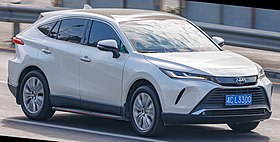This article needs additional citations for verification. (October 2019) |
| Toyota Harrier | |
|---|---|
 FAW Toyota Harrier (XU80, China) | |
| Overview | |
| Manufacturer | Toyota |
| Also called |
|
| Production | December 1997 – present |
| Body and chassis | |
| Class |
|
| Body style | 5-door SUV |
| Layout | |
The Toyota Harrier (Japanese: トヨタ・ハリアー, Hepburn: Toyota Hariā) is a five-passenger compact, later mid-size crossover SUV produced by Toyota since December 1997 in Japan, which was once exclusive to Toyopet Store Japanese dealerships. In export markets, the Harrier was rebadged as the Lexus RX from March 1998 to December 2008. At this stage, Toyota had yet to retail the Lexus brand to its Japanese customers.
The second generation (XU30) debuted in February 2003, along with the export Lexus version. The third-generation RX (separated from the Harrier) arrived in late 2008, while the Harrier continued on in second-generation form unchanged (although the second generation Harrier 350G, equivalent to second generation RX350, was discontinued after the release of third generation Lexus RX). Lexus had by now made its debut in Japan as an independent marque, thus the third-generation RX was sold in the domestic market in the same livery as its export counterpart.
The third generation (XU60) debuted in 2013, when it morphed into an independent model line constructed on a separate platform from the RX (the Harrier since then built on the same platform as the RAV4) but retaining a visual link with it. Starting at this point, it is considered as a more road-oriented and upmarket alternative to the RAV4, comparable to the luxury-class Lexus NX. From the fourth generation (XU80), it is also sold as the second-generation Venza in North America and China.
The Harrier is named for the eastern marsh harrier, a bird of prey common to Hokkaidō and northern Honshū called the chūhi in Japanese, and an emblem depicting the bird in stylized profile can be found on the grille until the XU60 model.
- ^ Capparella, Joey (18 May 2020). "Toyota Venza Returns for 2021 as Two-Row Hybrid-Only SUV". CarandDriver.com. US: Car and Driver. Retrieved 19 May 2020.